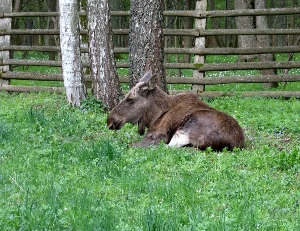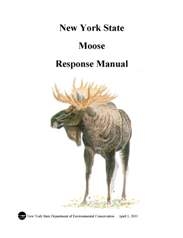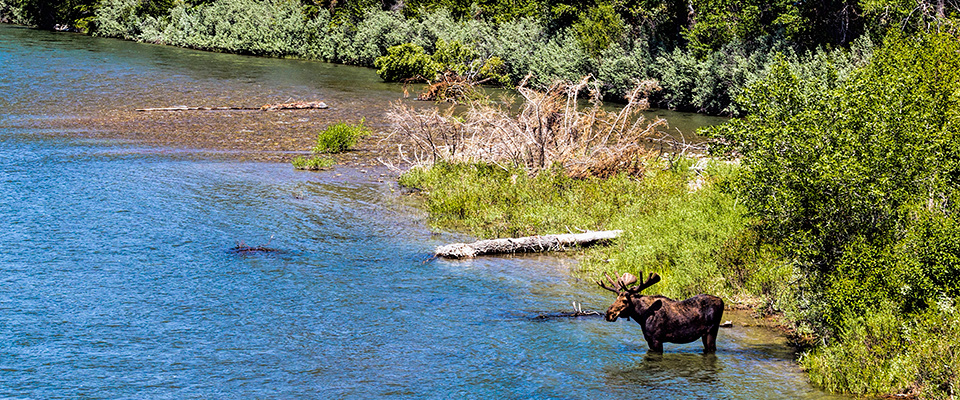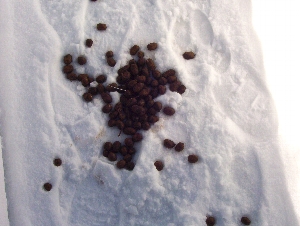Past and Present Efforts to Protect Moose Populations
 Following the death of the last moose in the park in 1861, people realized that moose serve a vital role in the ecosystem of the Adirondacks, and several efforts were made to reintroducethe species to the park. On a few occasions, private landholders tried to raise moose on their own land. These attempts were generally unsuccessful, because half of the moose died due to stress and extreme temperature change, once released into the park (Lee 2). In the early 1900s, the Browns Tract Guides Association tried a different approach, succeeding in keeping the moose alive by holding them in pens during the winter before releasing them in the spring. However, this method was ultimately unsuccessful because the moose essentially became domesticated and ended up wandering back to residential areas looking for food. Fearing these sometimes dangerous animals, many locals shot the moose within a few miles of their original release sites (Lee 3).
Following the death of the last moose in the park in 1861, people realized that moose serve a vital role in the ecosystem of the Adirondacks, and several efforts were made to reintroducethe species to the park. On a few occasions, private landholders tried to raise moose on their own land. These attempts were generally unsuccessful, because half of the moose died due to stress and extreme temperature change, once released into the park (Lee 2). In the early 1900s, the Browns Tract Guides Association tried a different approach, succeeding in keeping the moose alive by holding them in pens during the winter before releasing them in the spring. However, this method was ultimately unsuccessful because the moose essentially became domesticated and ended up wandering back to residential areas looking for food. Fearing these sometimes dangerous animals, many locals shot the moose within a few miles of their original release sites (Lee 3).
 Despite these various efforts to reverse man's decimation of moose populations in the Adirondacks, moose ultimately wandered back to the Adirondack region on their own time. As moose moved down from Canada between 1935 and 1980, the plausibility of reestablishing a population appeared greater, and moose conservation became a goal of New York wildlife management. Following the stabilization of the moose population in New York in the 1980s, the New York Department of Environmental Conservation (DEC) drafted an Environmental Impact Statement, which resulted in a temporary action plan (“Moose” 5). This document included numerous stated goals, including the DEC's support of the return of the moose, the need to monitor the species’ progress to ensure success and to meet the public’s demand for information about how to deal with moose in residential areas (“Moose” 5).
Despite these various efforts to reverse man's decimation of moose populations in the Adirondacks, moose ultimately wandered back to the Adirondack region on their own time. As moose moved down from Canada between 1935 and 1980, the plausibility of reestablishing a population appeared greater, and moose conservation became a goal of New York wildlife management. Following the stabilization of the moose population in New York in the 1980s, the New York Department of Environmental Conservation (DEC) drafted an Environmental Impact Statement, which resulted in a temporary action plan (“Moose” 5). This document included numerous stated goals, including the DEC's support of the return of the moose, the need to monitor the species’ progress to ensure success and to meet the public’s demand for information about how to deal with moose in residential areas (“Moose” 5).
Now that the Adirondack moose population is growing, scientists have further developed ways to monitor the current population size and ensure that it is stabilizing. This population is no longer solely made up of migrants, but now includes a true breeding population, which is an indication that moose have the potential to continue to grow in numbers (Hasse 2). The current population is already increasing at an estimated rate of 10-15% each year (Hasse 2).
Moose are not easy to spot in the wild, so scientist rely on indirect signs of moose such as tracks, scat, and known moose mortalities to determine a rough estimate of the population (Hasse 2). The DEC also relies highly on public wildlife sightings to determine the distribution of individuals throughout the region and record the types of habitat used by the species (Haase 2). Future efforts to monitor moose populations may include assessing the impacts of climate change, determining the role of moose in ecosystems, and developing a more detailed moose management plan (“Moose” 5).
Moose are not listed as endangered, but are currently protected in the State of New York, which does not permit them to be hunted. Unfortunately, moose are occasionally shot illegally in the park, often because they appear on private land, concerning residents who consider them a nuisance. However, if a person is caught killing a moose, strict consequences result. A man who recently shot a moose, claiming to mistake it for a deer was charged with illegally taking wild game, a misdemeanor and charged a $1,200 civil fine (Brown 3). Moose management differs for other states, such as New Hampshire, where a limited amount of hunting permits are given out ("Moose Hunting" 1). The number of permits allotted is relative to the moose populations, so may fluctuate each year depending on the abundance of the species. Many scientists believe that moose will not reach a level where they are permitted to be hunted in the Adirondacks because the boreal forest of the Adirondacks is predicted to suffer due to climate change. This ecosystem change would likely put stress on the moose populations, driving them northward to areas with more abundant resources.
_______________________________________________________________________________________________________
Sources Cited:
"Alces alces." Flickr. Yahoo, 5 Jan. 2007. Web. 11 May 2015.
Brown, Phil. "Hunter Admits Shooting Bull Moose." Adirondack Almanack. N.p., n.d. Web. 5 Apr. 2015.
Grimes, David. "Bull Moose on Snake River." Flickr. Yahoo, 2 July 2013. Web. 12
May 2015.
Dq5wh-qGvyNx-8Dx7zR-rFfDXN-HJFsQ-dbHPkk-dS8jMb-zZ6pn-ejQBYM-rBUNPM-aYt8LD-33DJtS-
2qkML5-BfB9S-rKCMg-4c1kvo-nAChrE-oDCFfn-aDVsXD-qc8BRL-pwqNtv-p3ieiw-bFjce-8hRXoj-
dsPksL-dvuypW-bV93wH-aq48Nr-6LyXmi-axm4fB-dDweVZ-oSeUDa-ofhSHY-niJNHq-3jWGVd-5FS9
t-o2auFL-4Qxcr-4c1kxL-giGyxs>.
Haase, Catherine. Creating a Public Moose Observation Database for the Adirondack State Park. N.p.: n.p., 2009. Print.
Lee, Gary N. "Moose Population Growing in the Adirondacks." Adirondack Outdoors. N.p., n.d. Web. 5 Apr. 2015.
"Moose." State University of New York, College of Environmental Science and Forestry. N.p., 1988. Web. 5 Apr. 2015.
"Moose Hunting." Vermont Fish and Wildlife. N.p., n.d. Web. 5 Apr. 2015.
"Moose Management Manual." New York State Department of Environmental
Conservation. New York State, n.d. Web. 11 May 2015.
"Moose Scat in Snow." Wikipedia Common. Wikipedia, 17 Mar. 2010. Web. 11 May
2015.

